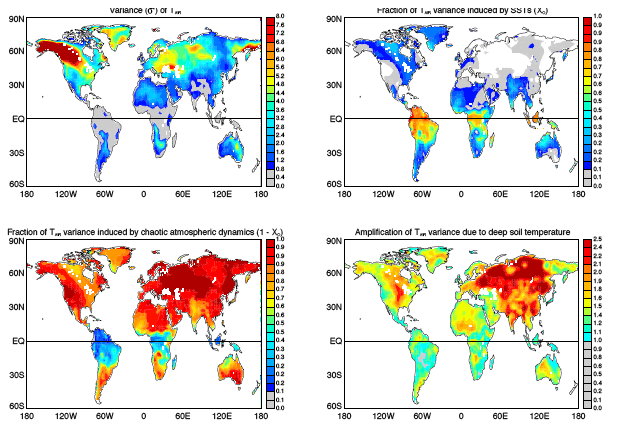|
Begin Main Content
Sarith Mahanama, Randal D. Koster, Rolf H. Reichle, and Max J. Suarez
The deep soil layer has a higher heat capacity than the Earth’s surface layer (by a factor of about 70) which prolongs the deep soil temperature response to the surface temperature changes. Thus, the heat capacity in the deep soil layer plays a critical role in understanding the inter-connection between colder-than-normal winter temperatures and subsequent spring temperatures or warmer-than-normal summer temperatures and subsequent fall temperatures. Given the complexity of the interwoven climate processes in nature, for e.g., surface temperature variability is directly associated with both the surface latent heat flux and the deep soil temperature, the heat capacity in the deep soil layer may also have important implications to the hydrological cycle (evaporation/precipitation). In this study, a physics based global climate simulation model was used to investigate the impact of subsurface heat content to the model’s surface air and precipitation variability.
Because of the dearth of decades-long observation records of meteorological variables for long-term analysis, the use of models to study the global climate variability is popular among the climate scientists. Moreover, the models can be handy tools in such analysis because models allow manipulation of key parameters or variables to test the required climate scenario. This study uses three long-term global climate simulations to isolate the contribution of deep soil temperature variability to variability elsewhere in the climate system -- model deep soil temperature was used as a measure of the heat content in the subsurface layer. The first control (CTL) experiment consists of a standard climate ensemble simulation in which the deep soil temperature variable is allowed to interact with the rest of the system. In the second experiment, the coupling of the deep soil temperature to the rest of the climate system is disabled -- at each grid cell, the local climatological seasonal cycle of deep soil temperature (as determined from the CTL experiment) is prescribed. Finally, a climatological seasonal cycle of sea surface temperature (SST) was prescribed in the third experiment. Together, the three experiments allow us to isolate the contributions of variable SSTs, interactive deep soil temperature, and chaotic atmospheric dynamics to meteorological variability.
The results show that allowing an interactive deep soil temperature does indeed significantly increase surface air temperature variability. The strongest impact was seen in the winter simulation through out the northern--hemisphere. An interactive deep soil temperature, however, reduces the variability of the hydrological cycle (evaporation and precipitation), largely because it allows for a negative feedback between evaporation and temperature.

(click on image to enlarge)
|
Figure caption: Breakdown of the contributions of oceanic, atmospheric, and deep soil temperature variance to Tair variance, assuming a linear framework for the boreal winter (DJF). Top left: Tair variance from experiments in which the deep soil temperature does not affect the atmosphere. Top right: The fraction of the Tair variance induced by variable SSTs. Bottom left: The fraction of the Tair variance induced by chaotic atmospheric dynamics. Bottom right: Amplification of variance due to deep soil temperature variance. |
Reference
Mahanama, S., R. D. Koster, R. H. Reichle, and M. J. Suarez, 2007: Impact of Subsurface Temperature Variability on Meteorological Variability: An AGCM Study. J. Hydrometeorology (submitted). (pdf)
|